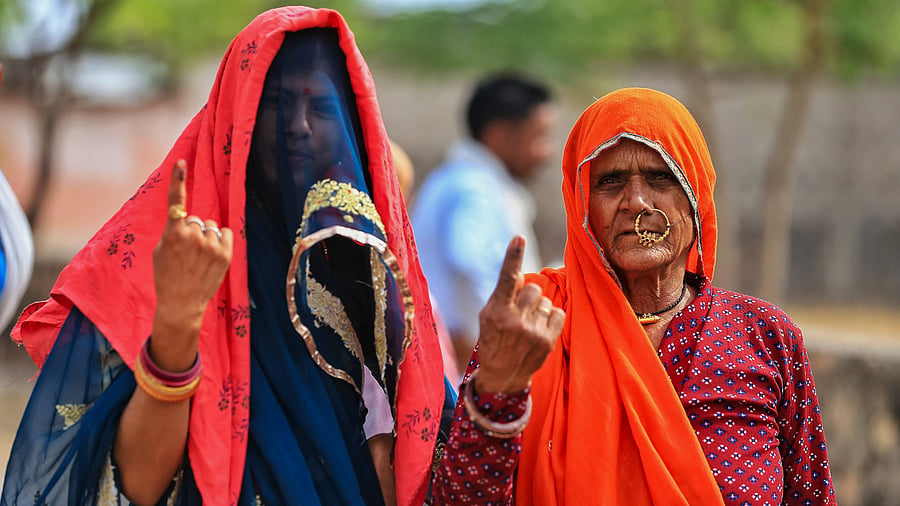
Women voters show their fingers marked with indelible ink after casting votes during the second phase of Lok Sabha elections, in Dudu district, on Friday.
Credit: PTI Photo
Jaipur: At least eight constituencies -- Churu, Sikar, Jhunjhunu, Pali, Jalore, Udaipur, Banswara and Rajsamand -- witnessed more female voters than male voters in the Lok Sabha Elections 2024, according to State Election Commission chief Praveen Gupta.
Percentage of female voters in Churu was 63.71 per cent as compared to 63.51 per cent of men while in Jhunjhunu, it was 54.03 per cent for women against 51.92 per cent men.
In Sikar, as many as 58.92 per cent women voted against 56.26 per cent men. In Pali, it was 57.25 per cent women voters against 57.13 per cent men. Jalore saw 63.35 per cent women against 62.48 per cent me, Udaipur witnessed 68.01 per cent women voters against 65.36 per cent men.
In Banswara it was 75.75 per cent women against 72.05 per cent men and Rajsamand saw 59.18 per cent women voters vote against 57.63 per cent men voters.
Pali and Rajsamand were the only two constituencies which had women as candidates. In Pali, Sangeeta Beniwal of Congress was up against BJP’s P P Choudhary while in Rajsamand, BJP’s Mahima Vishwaraj Singh from Mewar royal family was up against Congress’s Damodar Gujjar.
Out of the 200 Assembly constituencies of Rajasthan, 61 of them witnessed more women voters than men. The difference in voting percentage between men and women in these constituencies ranged from 0.06 to 10.74 per cent.
Bhim assembly segment under Rajsamand constituency witnessed the highest difference of 10.74 per cent, i.e 10.74 per cent more female voted as compared to male. Incidentally Bhim is the village from where the Right to Information movement started in which social activists like Aruna Roy and Nikhil De were involved.
Overall the tribal-dominated Banswara Lok Sabha constituency witnessed the highest women voter turnout, touching 75.75 per cent. On the basis of Assembly constituencies, Ghatol Assembly seat under Banswara witnessed the highest percentage of women voting, touching a high of 82.68 per cent.
The Assembly segments in Barmer Lok Sabha constituency like Baytoo recorded 82.12 per cent voting by women, Sheo touched 79.43 per cent, Garhi 78.53 per cent and Jaisalmer 78.21per cent.
In the second phase of polling on April 26 which saw 13 constituencies voting, the percentage of rural women voted more than urban women voters. Rural women voting percentage stood at 64.47 per cent while urban women voting percentage stood at 63.64 per cent.
Additionally, 56.33 per cent of third-gender voted in urban areas while 40 per cent third-gender votes were recorded in rural areas.
Rajasthan completed its voting in two phases April 19 and April 26. Of the total 2,56,27,971 women electorate, 1,55,61,285 women exercised their voting rights.
The voter turnout in the 2024 Lok Sabha has been lower as compared to the 2019 elections. The overall voter turnout stood at 61.60 per cent for the 25 Lok Sabha seats in the two phase election. In 2019, the overall voting percentage stood at 66.07 per cent.
There were 266 candidates - 247 male, 19 female - who contested in the 25 Lok Sabha constituencies.